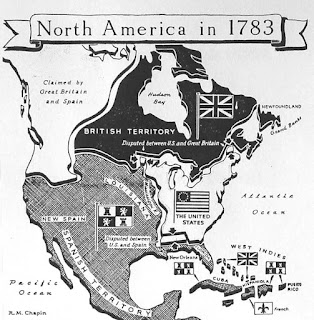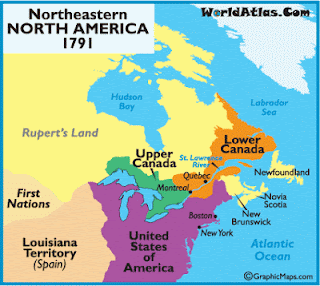October 13:
Warning: A
quiz is coming, as is an
evaluation about New France and its population and settlement...
Last week, we reviewed the European voyages of exploration and the claiming of land for France in North America by Jacques Cartier. This class bridged the "gap" between our examination of Aboriginal populations (territory, characteristics, culture and spirituality) and what we will now start - the establishment of a
French colony.
In 1608, Champlain established a permanent settlement - a fur trading post - at Quebec City. The population grew very slowly, throughout the French regime; in particular, it had a slow start in the first 50 years of its existence. After 1663, France took direct control of the colony and implemented measures that would increase the population.
The population of New France
inhabited a geographically small area - that of the St. Lawrence Valley. However, the boundaries of New France extended well beyond the occupied territory; by the 1720's, it stretched as far west as Saskatchewan, as far south as New Orleans, and as far east as Labrador (see maps below for evolution of territory). This territory had been claimed by explorers, missionaries and coureurs des bois.
Class 1: NF under company rule
In groups, you will brainstorm what you remember from last year; then, we will discuss and organise the information along a timeline. We will take 1-2 slides of notes (short!) about the period
1608-1663; and you will have four documents to examine that correspond to this period. They will allow you to "diagnose" what was the major problem in New France, with regard to its population. Your homework is to break down the documents and find the vital information. Luckily, they're easy!
Class 2: NF under Royal Government
I will show you how to break down documents and take from them the most vital information. The documents will focus on Talon's census and his findings; you will look at other documents and see the results of the measures taken by the government to increase NF's population (encouraging immigration and increasing the birth rate - see this about the
filles du roi...). You will take one slide of notes that summarise the
1663-1760 period.
Homework: Booklet
Summarise three
documents in one line; answer six questions (separate loose-leaf, full sentences), and complete a map outlining the
occupied territory of NF during the French Regime. I've included a concise and basic reading about Talon, as well as statistics (back page) regarding NF's population (age groups, immigrants...) over 150 years.
Class 3: French territory in North America
-organization of territory:
seigneurial system (elements & location)
-read about the
social groups in New France, in particular about the seigneur
Observe the maps below. Pay attention to:
-possessed territory vs. claimed vs. occupied territory
-the territorial growth btween 1645, to 1673, to 1712;
-location of NF's four towns (map 4)
 http://www.edmaps.com/html/canada.html
http://www.edmaps.com/html/canada.html










